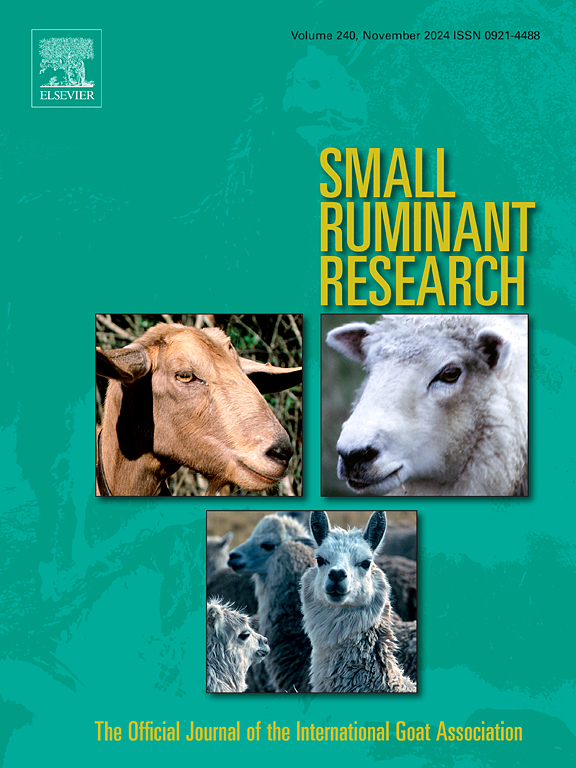Biometric and carcass analysis of lambs fed with forage palm silage and cottonseed cake
IF 1.6
3区 农林科学
Q2 AGRICULTURE, DAIRY & ANIMAL SCIENCE
引用次数: 0
Abstract
The growing recognition of the importance of ovine meat has strengthened the sector in various parts of the world, as interest in food quality has significantly increased. Thus, this study was conducted to evaluate the biometric and morphometric characteristics of carcasses from confined lambs. A total of thirty-two intact crossbred Dorper lambs, with an average live weight of 17 ± 1.5 kg, were slaughtered after reaching a body condition score of 3.5. The percentage and nutritional composition of the experimental diets were based on dry matter, consisting of 0, 20, 25, and 30 % cottonseed cake inclusion in a complete feed silage based on forage cactus. Biomorphometric characteristics, such as carcass composition and weight of edible viscera, were evaluated. Data on biometric measurements and carcass characteristics were subjected to descriptive statistics, Pearson's correlation, determination coefficient (R²), and multivariate analysis, while morphometric measurements were analyzed using canonical discriminant analysis through the Stepwise method to assess potential differences among treatments with cottonseed cake. CAN1 and CAN2 accounted for 73 % and 20 % of the total variation, respectively. The predictive models demonstrated high accuracy (R²=91 %), enabling producers who wish to implement the experimental diet to predict meat production based on biometric measurements. Chest depth was identified as the variable with the greatest discriminatory power in the morphometric analysis using the Stepwise method. A complete diet based on cactus silage with up to 30 % cottonseed cake can be used to estimate both slaughter weight and carcass characteristics of lambs. The predictive models showed high precision, making biometric evaluation an effective tool for estimating slaughter weight and carcass traits. Chest depth was the most discriminative variable among treatments. Including up to 30 % cottonseed cake in the diet also allowed for an effective estimate of slaughter weight, providing a practical approach to optimizing production and selecting high-performing animals before slaughter.
饲用棕榈青贮和棉籽饼羔羊的生物特征和胴体分析
随着人们对食品质量的兴趣显著提高,人们日益认识到羊肉的重要性,加强了世界各地的这一部门。因此,本研究旨在评估圈养羔羊胴体的生物特征和形态特征。选取32只平均活重为17 ± 1.5 kg的完整杂交杜泊羔羊,在体况评分达到3.5分后屠宰。试验饲粮的比例和营养组成以干物质为基础,分别为0、20、25和30 %棉籽饼在以牧草仙人掌为基础的全饲料青贮中添加。生物形态学特征,如胴体组成和可食用内脏的重量,进行了评估。采用描述性统计、Pearson’s correlation、决定系数(R²)和多变量分析对生物计量数据和胴体性状进行分析,采用典型判别分析,通过Stepwise方法对形态计量数据进行分析,评估棉籽饼处理之间的潜在差异。CAN1和CAN2分别占总变异量的73% %和20% %。预测模型显示出很高的准确性(R²=91 %),使希望实施实验饮食的生产者能够基于生物测量来预测肉类产量。在使用逐步方法的形态计量学分析中,胸深被确定为具有最大区别力的变量。以仙人掌青贮为基础,添加高达30% %棉籽饼的全饲粮可用于估计羔羊的屠宰体重和胴体特性。预测模型精度高,使生物特征评价成为估计屠宰质量和胴体性状的有效工具。胸深是治疗中最具判别性的变量。在日粮中添加高达30% %的棉籽饼也可以有效地估计屠宰体重,为优化生产和在屠宰前选择高性能动物提供实用方法。
本文章由计算机程序翻译,如有差异,请以英文原文为准。
求助全文
约1分钟内获得全文
求助全文
来源期刊

Small Ruminant Research
农林科学-奶制品与动物科学
CiteScore
3.10
自引率
11.10%
发文量
210
审稿时长
12.5 weeks
期刊介绍:
Small Ruminant Research publishes original, basic and applied research articles, technical notes, and review articles on research relating to goats, sheep, deer, the New World camelids llama, alpaca, vicuna and guanaco, and the Old World camels.
Topics covered include nutrition, physiology, anatomy, genetics, microbiology, ethology, product technology, socio-economics, management, sustainability and environment, veterinary medicine and husbandry engineering.
 求助内容:
求助内容: 应助结果提醒方式:
应助结果提醒方式:


